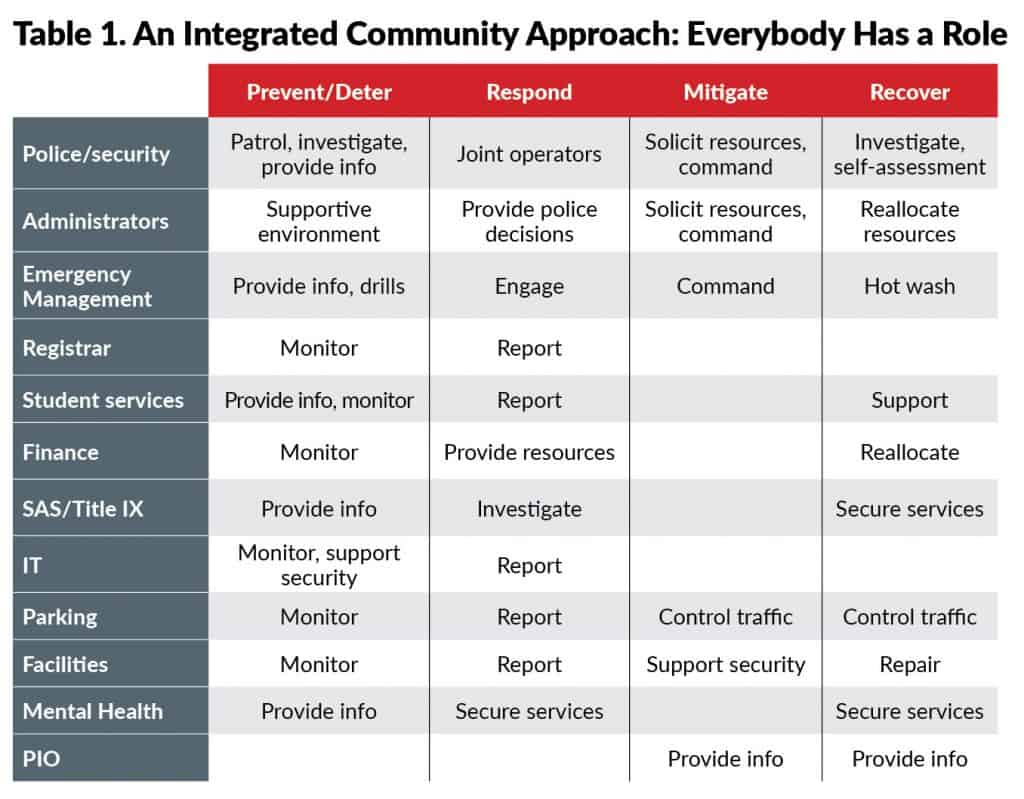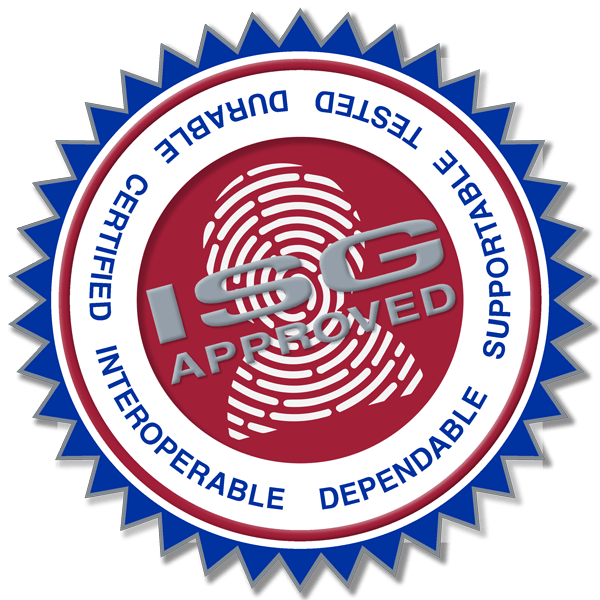Re-posted with permission from Campus Safety Magazine and edited.
Here’s how Northern Virginia Community College improved safety and decreased crime by adopting a campus support approach that includes a wide range of community stakeholders.
Ask anyone on campus who is responsible for safety and security and the unanimous answer will be police or security officers. This perception has never really been accurate but is even less true now because dynamic social, cultural and political changes preclude a continued business as usual approach to campus security.
Overcoming Campus Challenges
What are these dynamics that challenge police in maintaining safe and secure campuses? First, there are staffing problems within many campus police and security agencies. In light of social criticisms of law enforcement, stresses, irregular hours and the inherent dangers of the job, fewer people want to become cops.
As a result, recruiting and retention have become increasingly problematic, and the majority of campus public safety agencies are seriously understaffed.
Finding officers who are able to meet the unique challenges of campus policing and security is complicated by the fact that municipal agencies, which also are understaffed, are competing for the same desirable recruits.
Often, they offer higher salaries and greater career progression opportunities, increasing the probability that good officers hired by campuses will only spend a few years there before leaving for apparent greener pastures. This exodus is hastened to the extent that police have a negative reputation on campus.
At the same time, the job of protecting a campus is becoming more difficult. Police are called on to deal with new crimes, often in virtual reality as well as additional responsibilities (e.g., Clery, Title IX, VAWA, threat assessment teams) beyond those of their municipal colleagues. Training in these areas does not normally occur at regional municipal police academies where most prospective officers are trained.
There is also the “protect and serve” disconnect. College police must meet the same standards as municipal police but must be more service-oriented. The expectation of service taking precedence over protection is often not immediately apparent to many college officers who trained in municipal academies.
Another challenge is the expectation held by many on campus that police can prevent crime. Certainly, to an extent, police patrols deter crime and concerning behaviors since people are generally reluctant to engage in anti-social behavior in front of uniformed authority figures. However, anti-social behavior, whether it involves drug use, alcohol abuse or sexual offenses, are part of the campus environment and often, the only thing an officer can do is respond after the fact.
Other entities on campus have crucial roles in the most important phase of security: prevention. Unfortunately, the insular nature of higher education bureaucracy stifles communications between the many offices with responsibilities and capabilities to make campuses safer.
Another falsehood is the expectation that police authority can and should be exercised in non-criminal actions, such as responding to classroom discipline issues and campus protests.
Additionally, campuses are increasingly diverse and heterogeneous, with aging populations, different generations and the matriculation of tens of thousands of international students. Add to all of this the fact that campuses have been identified by various terrorist organizations as attractive targets and have always been turbulent stages for dissent and political agitation.
Plastering campuses with “If you see something, say something” posters and exhortations and waiting for tips to be directed to campus public safety is an unproductive strategy, because people see all kinds of things, but rarely report anything.
What is needed is a holistic focus on security that expands the usual focus of campus officials to include all phases of security challenges (prevention and deterrence, response, mitigation and recovery) and integrates all members of the campus community with responsibility, capability and perspective on the establishment and maintenance of campus support for safety and security.
Northern Virginia Community College (NOVA) adopted this approach, and the results are promising. The crime rate has gone down dramatically since 2010. Here is how NOVA achieved its impressive results.
A Holistic Security Approach is Needed
The following chart shows just a few of the roles various campus entities can play in addressing evolving security challenges.
The problem is how to integrate the disparate activities shown in Table 1, recognizing that a more systematic analysis would generate many more actors and cells.
The best way to begin unifying the approach to security is to identify the security goals common to all institutions. Those goals are to:
- Empower the campus community members with knowledge and confidence so they can protect themselves
- Integrate all groups and activities involved in campus support for safety and security
- Improve the effectiveness of police and security-related operations via training, standards and documentation
Empowerment
The hallmark of the educational process is the development of individuals who understand and appreciate what is happening around them, why it is occurring and how to become contributing members of society. People want to be more than passive objects who are acted upon. They want control of their own destinies, which means having information and capabilities that provide some control over their environments.
The empowerment of the campus support starts with the recognition that police cannot prevent all crime; that individual campus community members are ultimately responsible for their own safety and security. This recognition leads to an appreciation of the importance of situational awareness and how to protect one’s person and one’s environment. Situational awareness and self-protection are achieved by a robust outreach program.
At Northern Virginia Community College (NOVA), while human resources oversee the minimum required levels of annual training, NOVA Police dedicate two officers to outreach. Those outreach efforts include:
- Monthly trainings (e.g., dealing with difficult people; recognizing and reporting suspicious activities; active shooter response; staying safe in the classroom; crimes against women; a campus security and safety primer; and bystander intervention) on the college’s six campuses and three centers
- Monthly publication of a public safety newsletter, in collaboration with the Office of Emergency Management and Safety, that contains relevant safety information, training announcements, and various items showing police in a positive and approachable light
- An Instagram account, featuring Penelope the NOVA police cat, with daily safety tips: @penelopenovapolicecat
- Classroom lectures
- Sponsorship of community events (e.g., DEA drug take-back, and anti-texting and driving training and vehicle theft safeguards with the Virginia State Police)
- Initiatives to make reporting easier. These reporting initiatives include the centralization of dispatch and reporting operations; a single phone number for police dispatch, which serves as a gateway to other campus numbers; a user-friendly website with security-related information; and the provision of resources (e.g., the LiveSafe mobile safety app is made available, free of charge, to all members of the NOVA community) to make reporting easier, faster and anonymous and to provide critical safety information.
In addition to the aforementioned, specific NOVA police outreach programs include emphasizing personal interaction to keep officers out of offices and cruisers; outreach to international students that emphasizes constitutional safeguards, scams against foreign students, how policing in America differs from policing in many countries, etc.; giving senior leaders an appreciation of law enforcement by allowing them to respond to realistic scenarios in the college’s firearms simulator and to observe tactical officer training; sponsoring student clubs; and providing special services, such as child safety seat inspection and installation.
Stay tuned next week for Part II of this article.
Your Local ISG Dealer Can Help
The ISG provides campus security and safety solutions for colleges, universities, healthcare systems, government agencies and more, as well as crisis alert solutions for campus notification and communication with first responders.
Contact us today to talk with your local ISG representative about solutions relevant to your campus support and security needs.
Original article written by Chief Daniel Dusseau and Lt. John Weinstein for Campus Safety Magazine



